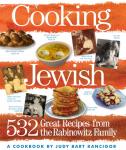
BUY COOKING JEWISH by clicking here now.
Cooking Middle Eastern memories
from The Jewish Journal of Greater Los Angeles
September 26, 2003
by Judy Bart Kancigor
Reading "A Fistful of Lentils" (Harvard Common Press) is like wandering through a family album. Instead of food photos you find dozens of family portraits, touching stories and the fascinating history of a rich and unique culture. In this engaging new cookbook, first-time author Jennifer Felicia Abadi tells the fascinating story of her Syrian Jewish family and reveals the secrets of their little known cuisine.
In 1924, her great-grandmother, Esther (called Steta in Arabic), left Aleppo for America on the crest of a wave of Syrian immigration as the Ottoman Empire crumbled. She brought with her cherished family recipes, passed down from mother to daughter, from the communal kitchens back home, where Arab and Jewish women gathered daily, as they had for centuries, to bake sambussaks (savory-filled pastries) and exchange gossip.
In the 1970s, Esther’s grandchildren (Abadi’s mother and aunt) decided to observe their Steta in the kitchen and carefully recorded her recipes for the family. Thirty years later, Abadi embarked on a project of her own — trying to fill in the gaps by observing her own grandma, Fritzie — and in the process learned as much about her family’s history as she did about their cooking.
Numbering a mere 150,000 worldwide, Syrian Jews descend from a blending of the Spanish Jewish population that fled to Syria to escape the Inquisition and the Mizrahi (Eastern) Jews they found there who had made Syria their home for 2,000 years.
Those who think Middle Eastern cuisine is all falafel and hummus will delight in the exotic tastes and smells of the Syrian kitchen. But what distinguishes the foods of Syria from other Middle Eastern cuisine?
"Syrian cuisine has a strong flavor," Abadi explained, "but as compared to, say, Indian, we don’t use a lot of different spices. We use mainly cinnamon and allspice in tandem together and lots of cumin. And whereas Moroccans, Algerians and Tunisians use couscous, we use bulgur wheat. We love rice, too, but bulgur wheat is our favorite grain."
Although rice was plentiful in Persia, Abadi noted, it was brought into Syria later through the trade routes. Originally reserved for the upper classes, the traditional riz (basic Syrian rice) is now considered a staple on the Syrian table. "Basic it is; plain it is not," Abadi writes.
Onions are first sautéed in oil and then combined with soaked and drained long-grain white rice, the mixture boiled and topped with toasted pine nuts. The favorite part of the rice is the prized a’hata, the brown crust scraped from the bottom of the pot, achieved by slowly cooking (and watching) the rice for 50-60 minutes over low heat.
Whereas Moroccans use dates, Syrians prefer mish mosh (dried apricots) in a variety of dishes, from Meh’shi Sfeehah b’Dja’jeh (Stuffed Baby Eggplant with Roasted Chicken) to the colorful and refreshing Mish Mosh m’Fis’dok (Cold Rose Water Syrup With Apricots and Pistachios).
"Many recipes call for rose water or orange water, and that separates us from other Mediterraneans, like the Greeks, who use honey," Abadi continued. "But I think probably our use of tamarind most distinguishes Syrian cuisine from others in the Middle East."
The rich tamarind sauce called ooh, a staple in the Syrian kitchen, is made from the pods of the tamarind tree. It is dark in color and lends a unique tart-sweet flavor to such dishes as Dja’jeh Mish Mosh (Sweet-and-Tart Chicken With Apricots) and Meh’shi Kusa (Stuffed Squash With Sweet-and-Sour Tomato Sauce). Presentation is key to the Syrian table.
"We’re definitely concerned with how the table looks and that all the food is presented colorfully," she said. "What’s nice is to have many little tastings, not just have one thing, and we like to have plenty. There will usually be several main dishes, on the average at least three or four, with a rice and a vegetable stuffed dish and maybe a noodle dish. The maazeh [appetizers] are colorful and done on little plates with lots of different shapes and sizes."
Most Syrian dishes, Abadi said, are easy to prepare.
"It’s peasant food, a home-cooking thing. The dishes are long cooking, but, except perhaps for the pastries, which require more time and skill, they are not that difficult to do."
Case in point, Dja’jeh b’Ah’sal (Chicken With Prunes and Honey), a perfect choice for Rosh Hashanah.
"We use prunes, as well as apricots and dates, not only for their sweetness," Abadi notes, "but because they are round, they represent the cycle of life."
Tired of the same old honey cake? Try the more exotic Ka’ikeh b’Ah’sal (Honey Cake With Sesame Glaze), rich with tahini and sesame seeds, which, Abadi tells us, are used on Rosh Hashanah along with poppy seeds to represent an abundance of good deeds.
RECIPES
Dja’jeh b’Ah’sal (Chicken With Prunes and Honey Sauce)
Ka’ikeh b’Ah’sal (Honey Cake With Sesame Glaze)

